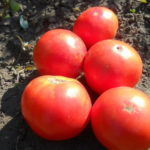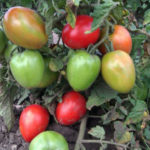Tomato variety Banana
Do you think it is difficult to grow a banana in central Russia or in Siberia? Not at all. True, in our conditions it will not be an exotic fruit, but a wonderful vegetable - a tomato called Banana. This variety is famous for its excellent taste and has several color variations. Of course, gardeners, who love everything new and unusual, tried each of them and made their own conclusions. Let's try and we, comparing the characteristics from professionals and amateurs, to compose a portrait of an unusual tomato variety.
Banana red
An application for registration of this variety was submitted in 1996 by LLC Agrofirma Gavrish and K and LLC Breeding firm Gavrish. The novelty was introduced into the State Register of Breeding Achievements in 1997 with admission in all regions of the country. Recommended for growing in open ground and in temporary film shelters in garden plots, in personal and small farms. This tomato is not a hybrid.
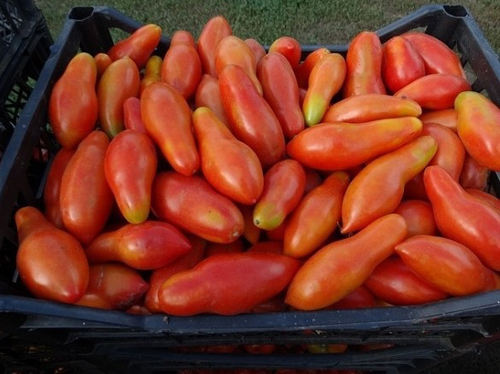
Description
The plant is determinate, creeping, about 70 - 100 cm high. Branching is strong, foliage is moderate. Leaves are of normal shape, medium size, slightly corrugated, light green, no stipule. Yellow flowers form 2 types of inflorescences - simple and intermediate. The first fruit cluster appears above 8 - 9 leaves, the subsequent ones are laid after 1 - 2 leaves. Each cluster has 8 to 12 ovaries. The peduncle is articulated.
The tomato has a pretty presentable appearance. The shape resembles a typical "cream" - the fruit of a red Banana is cylindrical, smooth, moderately elastic. Unripe tomato of this variety is light green. At the stage of consumer ripeness, it turns into a uniform red color. The peel is of medium density, according to reviews, it is sometimes even harsh, durable, glossy. The pulp is moderately juicy, fleshy, contains a large percentage of dry matter, without voids and a white core (only few reviews indicated a slight white spot, and then near the stalk itself), low-seeded. The number of seed chambers is 2 - 3. The State Register notes the taste qualities of fresh fruits as good and excellent. To some gardeners, the taste seemed ordinary, even herbaceous. The weight of the fetus according to the State Register is 70 grams, according to other sources - 100 - 120 grams. It is stated that the length of the fruit can reach 10 - 12 cm, although in the open field the real figure is almost 2 times less.
Characteristics
- Banana red belongs to the early maturing species. The declared period from the moment of emergence of full shoots to the beginning of ripening of tomatoes lasts from 90 - 95 days. The State Register indicates other terms - 107 - 114 days. This discrepancy is quite explainable by different climatic conditions;
- the yield of the variety is good - according to the State Register, from 2.5 to 3.0 kg of ripe fruits are removed from one plant, which absolutely coincides with the indications from other sources;
- the fruiting period stretches until the onset of cold weather;
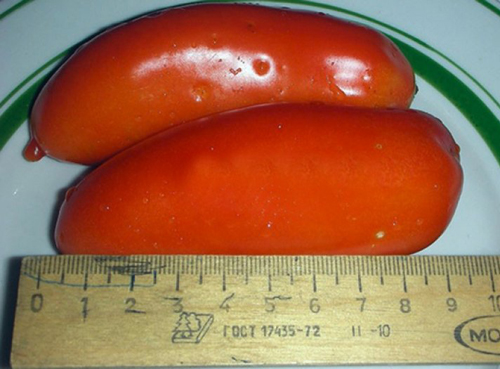
- the variety has medium immunity - moderately resistant to tobacco mosaic virus and fusarium, but can be severely affected by cladosporiosis. Although, according to numerous reviews of gardeners, during growth, diseases did not bother the tomato too much;
- resistance to changes in weather conditions is not bad, but gardeners growing the species in the Krasnodar Territory complain that the leaves of the plant begin to dry out from the extreme heat. Although, in general, bushes can withstand short periods of drought;
- strong skin of the fruit is not prone to cracking;
- transportability is excellent, tomatoes do not wrinkle, do not lose their presentation. Keeping quality also does not fail - with proper storage, the crop can lie for up to 3 months without signs of spoilage;
- the way of eating fruits is universal. This claim is often disputed by consumers who claim that there are varieties with more expressive flavors for salads. According to the majority - Banana red is great for canning, freezing and drying whole fruits.Tomato juice will fail due to the high solids content, but the paste will turn out wonderfully well, very thick. During the season, tomatoes are also used for cooking dishes - borscht, gravies, vegetable stew.
Agrotechnics
It is recommended to grow tomatoes through seedlings. Sowing of seeds is carried out from the end of February to the third decade of March, depending on the region. Seedlings aged 60 - 65 days with 5 - 7 true leaves are suitable for transplanting into the ground. If by the time of transplantation into the ground, the threat of recurrent frosts has not yet passed, then the plants are covered with a film cover. Choose a place that is as illuminated as possible - sunlight contributes to the accumulation of sugars. The recommended density is up to 4 pieces per 1 square meter. The bush requires a garter and moderate pinching. Usually it is customary to pinch the plant over 3 - 4 flower brushes. To increase productivity, the bush is formed into 2 - 3 stems. Some gardeners grow a plant with 3 to 4 stems.
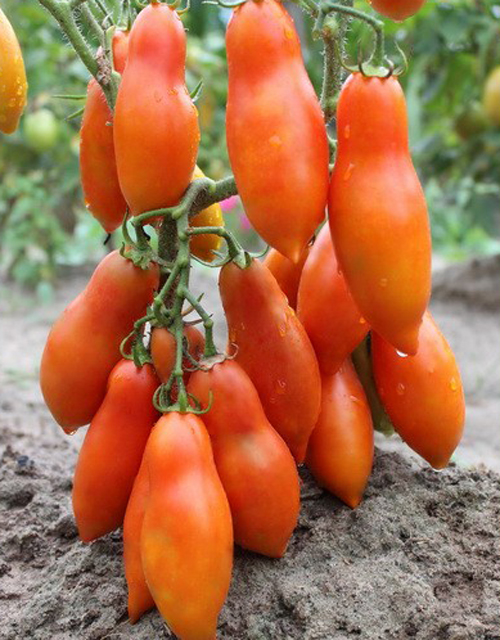
The care is pretty simple. The variety needs moderate watering, but sufficient to keep the soil in a moderately moist state. Top dressing is required - during the growth period, nitrogen is required, during the formation of the crop - phosphorus-potassium fertilizers. Loosening after watering breaks down the formed earth crust and helps to establish air exchange in the roots. Weeding frees the beds from weeds that compete with tomato bushes for moisture and nutrition. To preserve the harvest, preventive treatments against diseases and pests are necessary.
Banana red is prized for its high yields; housewives can use the crop for processing and whole-fruit canning, which perfectly helps to diversify the table in winter. Unpretentious in care, the culture works equally well for professionals and beginners. Of course, there are also dissatisfied, complaining about the low harvest. But this is more the exception to the rule than the norm. The only drawback of the variety can be called taste, and then if we compare it with salad tomatoes.
Banana orange
The orange-fruited namesake appeared in 2005. Its applicants were 3 firms at once - Scientific Research Institute of Vegetable Plant Breeding LLC, Agrofirma Gavrish LLC, and Gavrish Breeding Firm LLC. Since 2006, the variety has been in the State Register of Breeding Achievements of the Russian Federation with admission in 7 regions - North-West, North, Central, Central Black Earth, Volgo-Vyatka, North Caucasian and Middle Volga. Recommended for growing under film shelters in personal subsidiary plots. Not a hybrid.
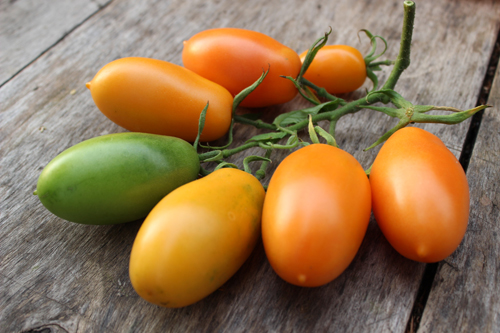
Description
The plant is indeterminate, about 1.5 meters high or taller. The stem of the variety is not too thick. Tomato leafiness is moderate. Leaves are medium in size, long-petiolate, regular in shape, green. The inflorescence is of a simple form. Fruit clusters are laid through 3 leaves. 5 - 6 brushes are formed on the main stem. One brush has up to 7 ovaries.
Banana orange fruits are elongated, cylindrical in shape, smooth, moderately elastic. An unripe tomato is light green, when ripe it turns into an even bright orange color. Thanks to this, the bush, decorated with ripe tassels, looks decorative. The pulp is very fleshy, with a high content of lycopene, tender, moderately dense, juicy, contains few seeds, aromatic. Seed nests are small, from 2 to 3. Tomato peel is thin, shiny. The taste of fresh fruits of this variety is excellent, you can feel sweetness, and the sourness can remind you a little of itself in slightly unripe tomatoes. According to the State Register, orange-fruited tomatoes are slightly larger than red-fruited ones - weighing from 85 to 92 grams.
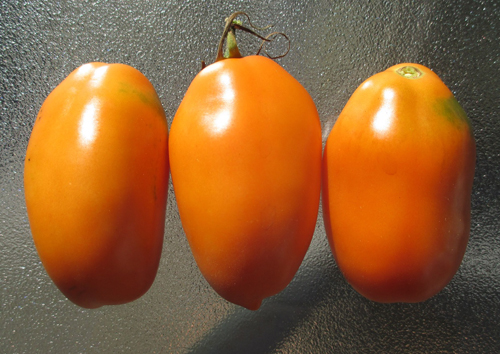
Characteristics
- In terms of ripening Banana orange belongs to the mid-season species. The period from the emergence of full shoots to the beginning of ripening lasts 105-110 days;
- the yield is good - 3 - 3.5 kg of ripe fruits are removed from one bush. According to the State Register, the indicator of marketable yield is 8.3 - 9.2 kg per 1 square meter. According to the calculations of gardeners, one bush can give up to 40 bright tomatoes;
- the immunity of the tomato is very good, there is a high resistance to fusarium and cladosporium, which can cause trouble for the red-fruited Banana;
- the plant is unstable to cold snaps, therefore, at the first time after transplantation, the film shelters should not be removed completely;
- the skin is not strong enough to protect the fruit from cracking;
- The harvest of this variety tolerates transportation well, but for this it is still desirable to remove the fruits at the stage of technical ripeness. Shelf life is excellent, according to some reports, it is about 2 months, subject to storage standards;
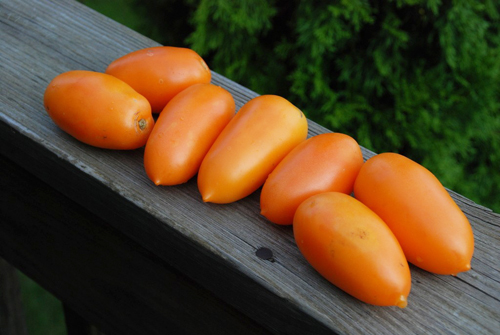
- the way of eating fruits is universal. The gardeners agree with this statement unanimously. Tomatoes are great for salads, whole-fruit canning (they are very good in cans, especially with other multi-colored tomatoes), processing into tomato products.
Agrotechnics
It is also recommended to grow this variety through seedlings. In order for the culture to show its maximum potential, it is recommended to form it into 1 - 2 stems with mandatory pinching. The rest of the agricultural technology is very similar to that already described above. The only differences are in the frequency of watering. Here it should be borne in mind that the soil remains moist under a film cover longer than in an open bed.
Banana yellow
This cheerful variety was introduced to tomato growers quite recently - in 2013. Applicant - Agrofirma Poisk LLC. The variety was entered into the State Register in 2015 with admission in all regions of Russia. The tomato is recommended for growing under film shelters in personal subsidiary plots. Not a hybrid.
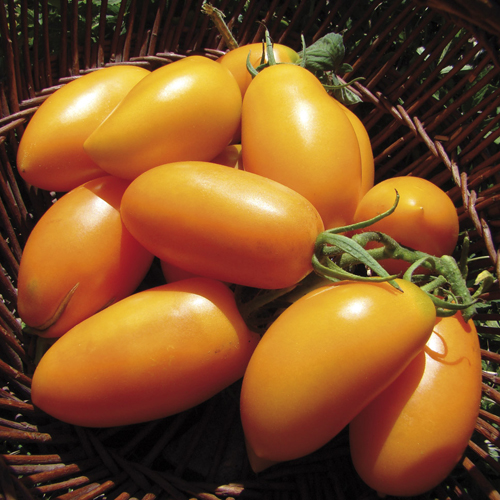
Description
The plant is indeterminate, about 2 meters high. The stem and shoots are strong. The foliage is good. Leaves are of normal shape, medium size, light green. The inflorescences are of an intermediate type; quite a lot of ovaries are formed in them - about 10. Fruit clusters are formed through 2 leaves. The peduncle is articulated.
The fruits of the variety are beautiful, oblong, smooth, dense, but in moderation. On the bush they look like a small bunch of bananas. The length of the tomato is about 8 cm, the weight is 100 - 120 grams. An unripe tomato is light green, may have a slightly pronounced striping, when ripe it turns into an even bright yellow color. The pulp is fleshy, tender, juicy, contains a small amount of seeds, seed nests - 2. The content of dry matter is average. Excellent taste, sweet flesh.
Characteristics
- The banana is yellow in terms of ripening, mid-season. The first tomatoes ripen 125 days after full sprouting;
- the yield of marketable fruits is quite good - according to the State Register, it is 6.8 kg per 1 square meter;
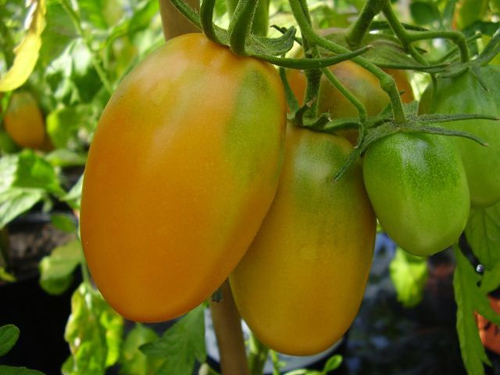
- the available information on immunity indicates the resistance of the variety to the tobacco mosaic virus;
- tomatoes are resistant to cracking;
- good portability;
- the way of use is universal. Tomatoes make excellent bright salads, they are also suitable for whole-fruit canning and processing into tomato products.
Agrotechnics
Planting seeds for seedlings is carried out taking into account climatic features. The seedlings are transplanted to a permanent place after 2 months, when the plant has 7 - 8 true leaves. Planting pattern - 40 cm between bushes, 60 cm row spacing. The bush must be tied up and stepson. Recommended to grow in 2 stems. Otherwise, the care of the variety is in accordance with the generally accepted for the culture as a whole.
Banana yellow is a very young variety, but already quite famous among tomato growers. This was facilitated by a good yield, good immunity, unpretentiousness, and most importantly - a bright appearance and excellent taste of tomatoes. Nothing is known about the shortcomings yet.
In conclusion, I would like to remind you that each tomato grower can collect seeds from the variety he likes on his own.The grown crop will fully comply with the declared characteristics. There are many reviews about the multi-colored varieties of Banana, most of them are positive, many tomato growers have been growing the crop for more than one year and are not going to give it up.
